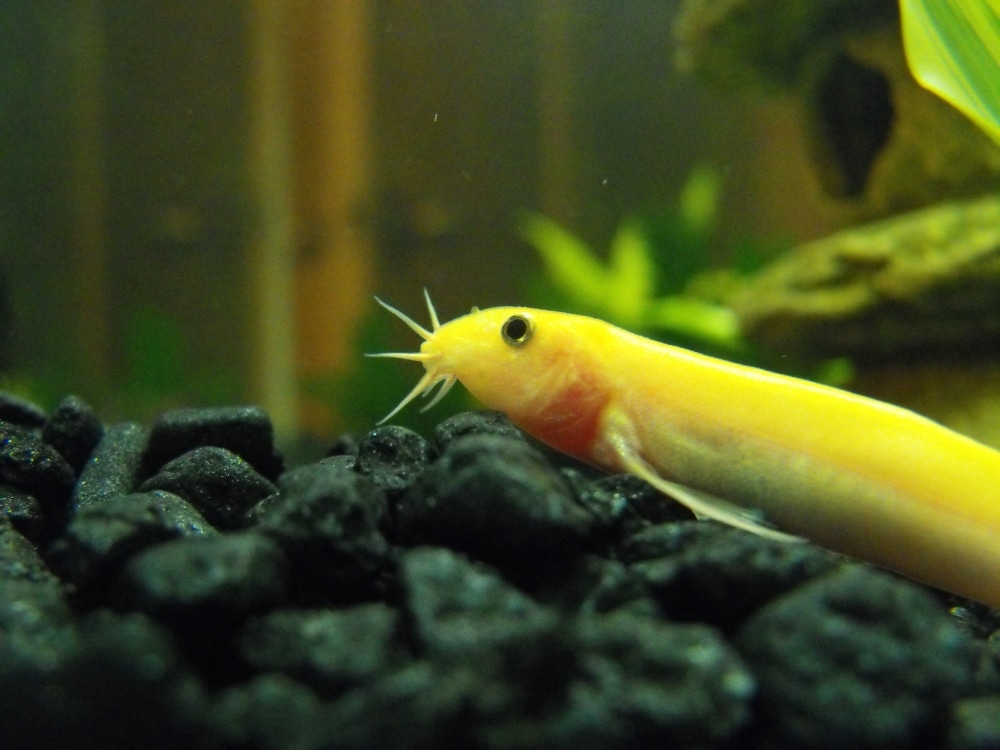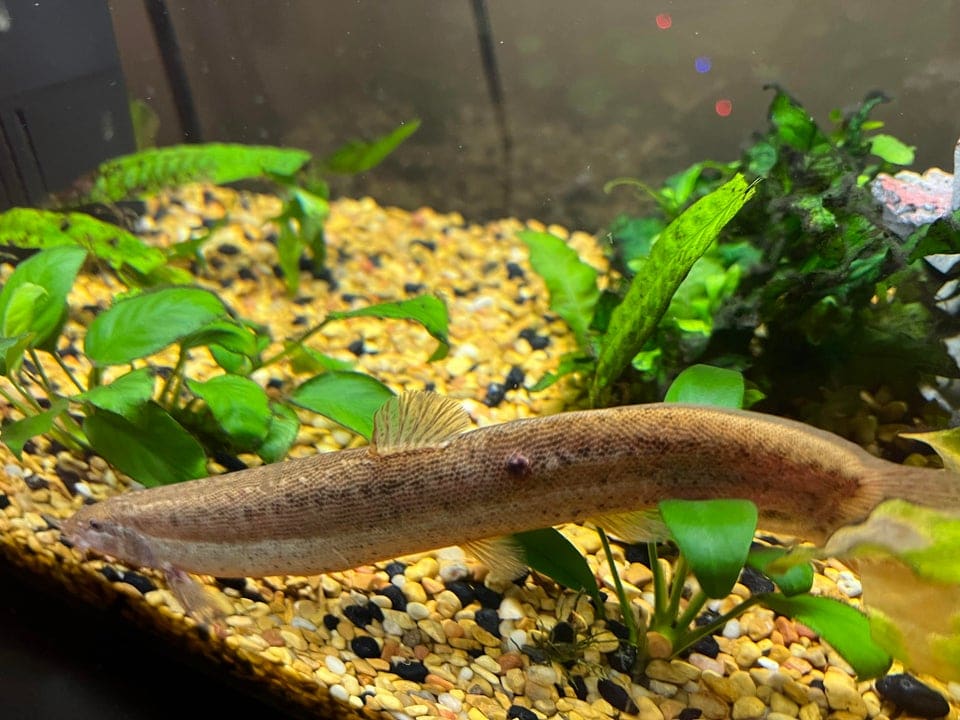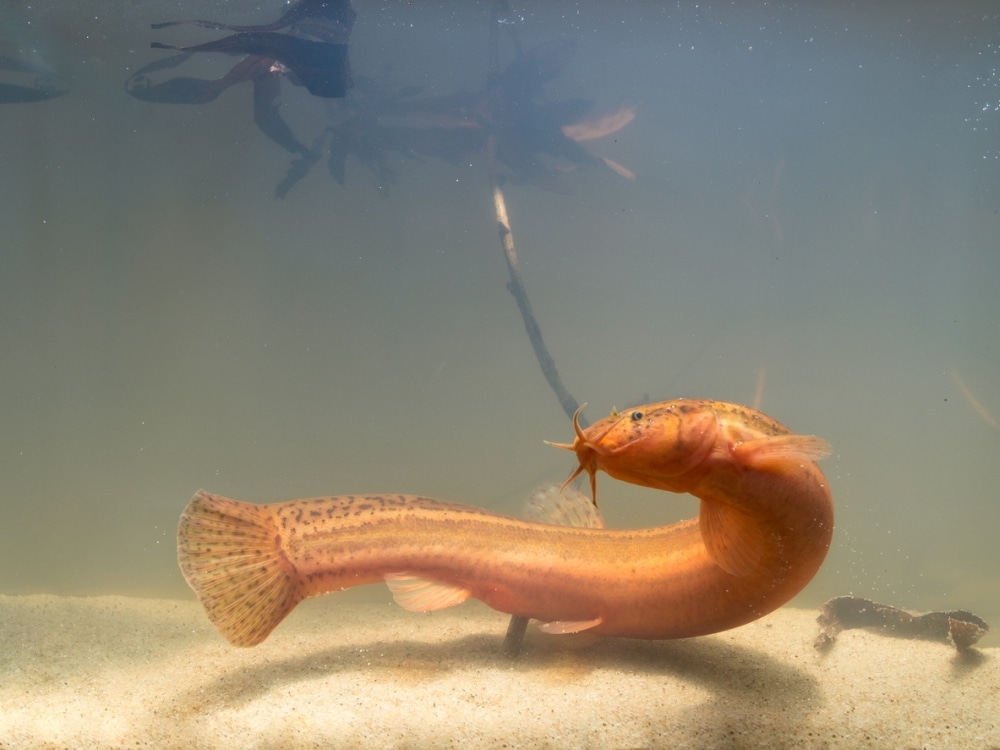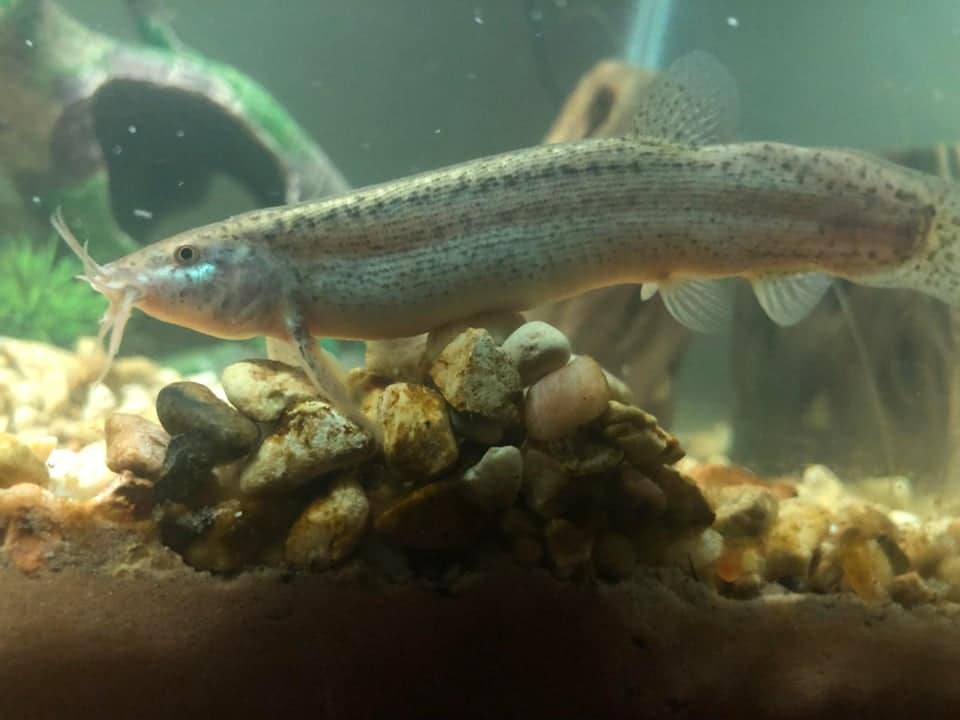King Dojo Loach. Weather Loach. Both of these names refer to the somewhat goofy-looking Dojo Loach, a fish that is increasingly popular in the West as an aquarium pet – and in the East as a food fish!

But are Dojo Loaches worth keeping as pets? What about Dojo Loach’s size and temperament? Let’s take a closer look at these strange fish!
Getting to Know the Dojo Loach
Dojo Loach fish are also known as Weather Loaches for a very interesting reason! Their ability to breathe air makes them hypersensitive to changes in atmospheric pressure. So when storms are approaching, the change in pressure affects them even beneath the water’s surface. Dojo Loaches will start acting crazy, swimming around rapidly and even standing on their heads on occasion.
Why they do this is unknown; it’s possible they are preparing to move onto land. Dojo Loaches can temporarily move onto moist land to wriggle to new ponds and streams during a rainstorm or when morning dew keeps them from dying out. This ability to take brief land journeys means a tight fitting aquarium lid is essential, otherwise, you might find a Dojo Loach on the floor of your fish room!
As I mentioned earlier, Dojo Loaches are sold as food fish; in fact they are the 30th most important aquacultured animal in the world, going by 2018 numbers. In their native range of East Asia they are sold for soup and fish dishes where their rich, soft meat makes a savory addition.
Like goldfish, they are very hardy and will eat anything, making them the aquatic equivalent of pork. But this adaptability also makes them great pets! So what is involved in Dojo Loach care?
- Scientific Name: Misgurnus anguillicaudatus
- Origin: East Asia
- Length: 6 to 8 inches
- Aquarium Size: 20+ Gallons
- Temperament: Peaceful
- Ease of Care: Very Easy
Dojo Loach Care
Dojo Loaches are durable generalists that eat almost anything and can survive low oxygen, high ammonia levels, and other conditions that would kill most fish!
Dojo Loach size is also very manageable, making them good residents for almost any aquarium.
Size of Aquarium
A full-grown Dojo Loach should be kept in an aquarium no smaller than 20 gallons. These fish grow between 6 to 8 inches long on average. But sometimes a full-grown Dojo Loach will reach 12 inches when kept in temperate outdoor ponds.

While they are occasionally very active (especially during storms) they aren’t as bulky as other fish their length so their bioload is low enough for a 20-gallon tank.
If you decide to buy more, increase the tank size by 5 to 10 gallons per additional Dojo Loach! They aren’t especially social but they aren’t aggressive towards each other either. Just hyper-competitive when it’s time to eat!
Aquascaping for Dojo Loaches
When setting up a Dojo Loach aquarium there are a few things you should keep in mind. The first is that these fish are natural escape artists. Dojo Loaches can spend brief to long periods on land, especially during and after a storm when the ground and air are moist.
If they sense a storm is approaching and start going wild, your Dojo Loach may start testing the aquarium lid, trying to get out. These fish are thin bodies and slimy; any hole that is small enough for their head will allow the entire fish to escape.
This means holes for power cables and hang on the back power filter pipes are all possible escape points for them. You should secure these points with blocks of foam, cardboard, or anything else you have on hand to block their exploration. It’s not common for one to try hard enough to escape but it only takes one failed adventure for a Dojo Loach to end up on the floor dried up and dead.
Second: choose your substrate very carefully. In nature Dojo Loaches prefer living in ponds and slow moving streams with muddy or sandy bottoms. They can do all of the burrowing they like for worms and other invertebrates.
Gravel is very rough on their scaleless skin, especially if your Dojo Loach is acting crazy during a storm or panics in fear and tries to bury itself, as almost all loaches love to do. It will likely get scratches from rough gravel that can easily become infected. So keep your loaches on either fine gravel or sand whenever possible!
Dojo Loach Lifespan
Dojo Loach lifespan depends strongly on your water temperature. While they are hardy enough to thrive in tropical tanks they really do prefer temperate environments. Warm water boosts their metabolism considerably, speeding up their appetites, cell division, and life spans.
A Dojo Loach kept in cold water will live for 7 to 10 years; one living in a tropical aquarium with temperatures above 73℉ is more likely to live for 4 to 6 years. So keep your Dojo Loach fish cool and alongside other cold water fish if you want them to live a full life!
Normal versus Albino and Golden Dojo Loaches
There are two main color morphs of Dojo Loach available in the hobby: the normal and Golden Dojo Loach. The origin of the Golden Dojo Loach is the same as that of the Goldfish; both were originally raised as food fish in large ponds in China, Japan, and Korea.
Occasionally, a golden mutant would arise from the many muddy green normal fish. And when found, people would see them as unique or even symbols of good luck! By breeding them with other golden fish, the Goldfish and Golden Dojo Loach became their own strain of pet!
Golden Dojo Loaches have the exact same care requirements as their regular colored cousins. When seeing a Dojo Loach for sale the golden form will cost a little bit more. But these fish are raised in such huge numbers that they are never very expensive!
Occasionally you will also see true albino Dojo Loaches in the hobby! You can tell an albino by its brilliant pink eyes; Golden Dojo Loaches lack these. Albino Dojo Loaches also have the same care requirements as their Golden and normal cousins.
Dojo Loach Water Conditions
One main reason why Dojo Loaches are so very popular as both food fish and pet fish is that they are very hardy. Dojo Loaches can tolerate a wide range of water conditions that would kill most other fish.

By far the most important consideration is the water temperature. Dojo Loaches are temperate fish, meaning they come from regions with moderate summers and a true spring, fall, and winter; places like Korea, Japan, and most of the United States. Therefore they prefer a range of 50-73℉.
True tropical conditions can cause them minor stress over the long term; while it won’t kill your Dojo Loach to keep them alongside tropical fish it will shorten their lifespan by up to 50%. Instead of 7 to 10 years of life you’re looking at 4 to 6 years.
Dojo Loaches prefer neutral to alkaline water (pH 7.0+), which is perfect since most tap water tends to be mineral rich and alkaline. But they will still do well in softer acidic conditions so long as they don’t become too extreme.
Dojo Loaches are extremely tolerant of high levels of ammonia, nitrite, and nitrate. In fact, they are almost immune to the effects of ammonia, a rarity in any animal. They have specialized adaptations to living on land and in muddy holes for brief periods.
Since fish normally pass it via urine and through their gills into the water, being on land would normally cause a toxic buildup of ammonia. But Dojo Loaches have complex metabolic pathways allowing them to pass ammonia in unique ways.
That said, it’s good to remember that ammonia and other nitrogenous waste are still poisonous. Dojo Loaches being highly resistant to poison is not an excuse to keep them in poor water conditions. Especially since these conditions also foster the growth of bacteria and fungi, which they have no special immunity to.
In fact, like all scaleless fish, Dojo Loaches are more sensitive to opportunistic skin infections. And they are harder to treat since you need to be cautious when dosing scaleless fish with medications. It is easy to overdose and kill scaleless fish because they absorb much more than fish with hard scales.
Dojo Loach Tank Mates

Since they are so very peaceful Dojo Loaches are an ideal addition to any community tank! They have small mouths so they can’t eat even small tank mates despite not being small fish themselves. The main problem is finding fish that prefer the same cold water conditions as they do.
Fortunately, you do have some options! If you are keeping your Dojo Loach at room temperature, which they prefer, try other cyprinid fish! These include Goldfish, Danios, and Barbs. Zebra Danios are a popular and colorful choice for coldwater tanks, as are Celestial Pearl Danios!
Dojo Loaches are also great outdoor pond fish that will overwinter in temperate ponds no problem so long as they are deep enough. This means they can live alongside Goldfish and Koi with no issues; both fish are peaceful and all eat the same sort of food!
If you decide to keep yours in tropical conditions then the same rules apply: choose small to large tank mates that are peaceful and not territorial. Bottom dwellers like Red Tail Sharks and Cichlids should be avoided. These aggressive fish will stress Dojo Loaches out since they have no concept of “territory” and will constantly find themselves being chased by their neighbors.
Good Dojo Loach Tank Mates:
- Goldfish, Koi, and other Pond Fish
- Danios, Barbs, Livebearers, and other Cold Water Fish
- Other Dojo Loaches
Poor Tank Mates for Dojo Loaches:
- Cichlids, Freshwater Sharks, Large Catfish, and other Aggressive Tank Mates
- Small Snails or Shrimp (will be eaten by a Dojo Loach)
Feeding Dojo Loaches
Feeding the Dojo Weather Loach is as easy as it gets! These fish are hearty omnivores, just like Goldfish and other cyprinid fish. This means that they need to eat both plant and animal matter. In the wild a Dojo Loach will slurp up worms, algae, soft aquatic plants, fish eggs, small snails, and anything else they come across on the bottom of a pond or stream bed.
This means that their digestive system is versatile and adaptable. A Dojo Loach will eat anything you offer it, including prepared flake and pellet food formulas.
I always recommend feeding your Dojo Loach pellets because they can be shy about feeding from the surface at first. Sinking pellets ensure that they won’t go hungry in case your other fish are too ravenous to allow food to reach the bottom.
Supplement your flakes or pellets with good quality fresh and frozen foods like brine shrimp, blood worms, daphnia, and tubifex worms. Only feed tubifex and other worms sparingly because they are very high in fat. A good source of greens like spirulina flakes is also good for the vitamins and minerals plant based foods contain that animal matter doesn’t.
So long as you are providing them with a balanced diet full of variety you have little to worry about. And you may even find your Dojo Loaches ready to breed one day!
Dojo Loach Breeding
Dojo Loaches are not especially easy nor difficult to breed so long as you’ve followed everything outlined in this Dojo Loach care guide!
Sexing Male and Female King Dojo Loaches
Unfortunately telling the sexes apart in Dojo Loaches is very difficult. Females will appear visibly chunkier when carrying eggs. But otherwise, both fish look like thick sausages. One way to tell is to look at your fish from above.
A male full-size Dojo Loach will have triangular pectoral fins when viewed in this way. On the other hand, a female full-size Dojo Loach will have more rounded ones.
Spawning Dojo Loaches
The main reason why more people don’t breed Dojo Loaches is that they are being kept too warm. Remember, these are temperate fish so they prefer cooler conditions. In fact a heater pretty much guarantees your Dojo Loaches won’t be breeding.
Keeping them in room temperature water really helps. Since we all live in temperature-controlled rooms though, your Dojo Loaches won’t get the seasonal cues that normally trigger egg production in females. Outdoor ponds are where you are most likely to succeed in spawning them.
Like all cyprinids Dojo Loaches are egg scatterers. The males and females briefly embrace among aquatic plants, scattering their sticky eggs into the area and then leaving the fry to fend for themselves. You will likely not even know your Dojo Loaches have spawned until one day you find baby Dojo Loaches looking for food along the pond or tank bottom!
Frequently Asked Questions about the Dojo Loach
There is a little variability in Dojo Loach size. 6 to 8 inches is typical for home aquariums but in an outdoor pond a Dojo Loach can get up to 12 inches long!
Dojo Loaches are very peaceful fish; even towards one another.
Dojo Loaches will eat almost anything; flakes, pellets, fresh, and frozen foods. What is important is giving them plenty of variety in the form of both plant and animal matter!
Only if the fish would fit inside its mouth and is slow enough to be caught. So baby or young guppies might be in danger but not an adult Guppy.


I followed your bad advice. My Dojo Loach killed 18 adult guppies in 2 days. Please stop saying they are peaceful.
I love my Loach and it eats out of my hand but it has killed other, smaller Dojos as well. Please take down this post before you waste tons of another persons’ money.
George they are very peaceful i have 3 adult Dojos and one baby one and i kept them with guppies and they were fine. My Dojos didn’t mind them at all. Maybe your Dojos might be missing something i looked over this page and it seemed pretty good if you need any help feel free to ask me!
It took me sometime to know what they need and everything.
Have a wonderful day